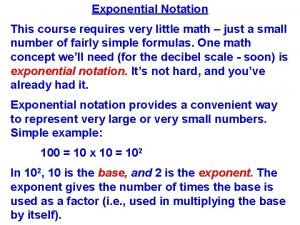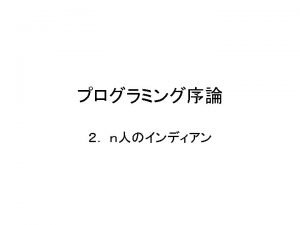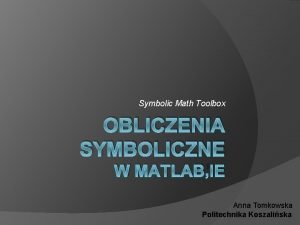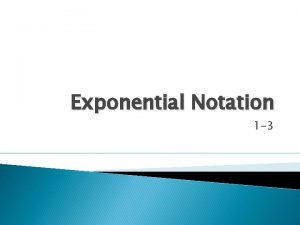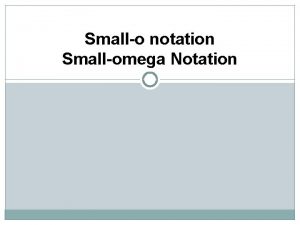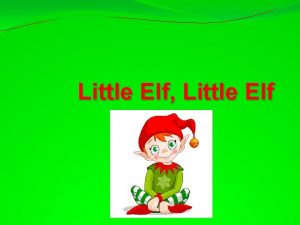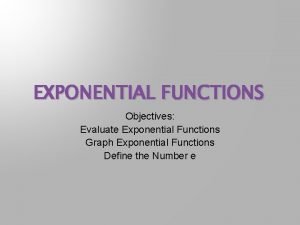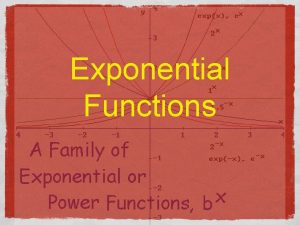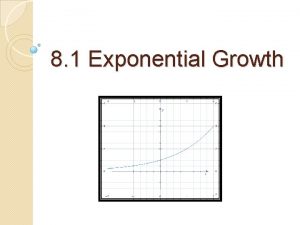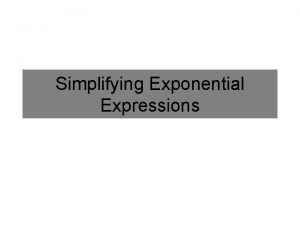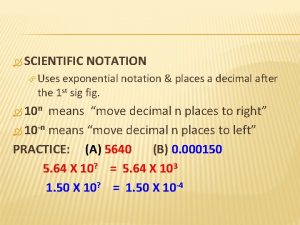Exponential Notation This course requires very little math














- Slides: 14

Exponential Notation This course requires very little math – just a small number of fairly simple formulas. One math concept we’ll need (for the decibel scale - soon) is exponential notation. It’s not hard, and you’ve already had it. Exponential notation provides a convenient way to represent very large or very small numbers. Simple example: 100 = 10 x 10 = 102 In 102, 10 is the base, and 2 is the exponent. The exponent gives the number of times the base is used as a factor (i. e. , used in multiplying the base by itself).

Note: The base does not need to be 10 (although that’s the only one we’ll need). It can be 2 (the base that’s used in digital computers – i. e. , binary, 0 s and 1 s); it can be 16 (hexadecimal, a coding scheme used by computer nerds); it can be anything it wants to be. The decibel scale uses base 10, so that’s all we’ll work with. (We will not get to this for a while. )

___________________________________________________________________________ Exponential notation for even (whole number) powers of 10. Exponential Number Notation Factors of 10 ______________________________________ 1 10 100 1, 000 100, 000 1, 000 100 101 102 103 104 105 106 (any number raised to the zero power = 1) 10 x 1 = 10 (‘times 1’ is implied in all of these) 10 x 10 = 100 10 x 10 = 1, 000 10 x 10 = 10, 000 10 x 10 = 100, 000 10 x 10 x 10 = 1, 000 ___________________________________________________________________________ Whole-number powers of 10 are simple: The exponent is the number of zeroes used when the number is written in ordinary notation. 100 = 102, 10, 000 = 104, 1, 000 = 106 , 1, 000, 000 = 109, …

What do you do with positive numbers that are smaller than 1, like 0. 01? The convention is pretty simple: 0. 01 = 1/100 = 1/102 = 10 -2 To go at it from the other direction: 10 -2 = 1/100 = 0. 01 How do you write 0. 001 in exponential notation? 0. 001 = 1/1, 000 = 1/103 = 10 -3 How about 0. 1? 0. 1 = 1/101 = 10 -1 (There’s an easy zero-counting system for these too. Soon. )

____________________________________________________________________ Exponential notation for positive numbers less than 1. Exponential Number Notation Factors of 10 __________________________________ 0. 1 10 -1 1/10 = 1/101 0. 01 10 -2 1/(10 x 10) = 1/102 0. 001 10 -3 1/(10 x 10) = 1/103 0. 0001 10 -4 1/(10 x 10 x 10) = 1/104 0. 00001 10 -5 1/(10 x 10 x 10) = 1/105 0. 000001 10 -6 1/(10 x 10 x 10 x 10) = 1/106 ____________________________________________________________________ Zero-counting rule for whole-number powers of 10: The exponent is the number of zeroes plus 1 (but with a negative sign); e. g. 0. 01, 1 zero+1, exponent=-2; 0. 0001, 3 zeros+1, exponent=-4; 0. 000001, 5 zeros+1, exponent=-6.

Last point on negative exponents: Don’t lose track of the basic idea, which is pretty straightforward: 10 -1 = 1/10 = 0. 1 10 -2 = 1/100 = 0. 01 10 -3 = 1/103 = 1/1, 000 = 0. 001 10 -4 = 1/10, 000 = 0. 0001. . . That is pretty much it.

The Dreaded Logarithm We’re going through all this because we will need it later when we talk about the decibel (d. B) scale, used (mainly) for the measurement of sound intensity. The d. B scale is logarithmic. Most students are comfortable with the concept of an exponent, but logarithms sometimes strike fear. But this is usually because the concept is not taught well. Here’s the main joke: a logarithm is an exponent. A log is not like an exponent, it is an exponent.

base 2 10 exponent OR power OR logarithm All three terms – exponent, power, and logarithm – are completely interchangeable. An exponent is a power, a power is a logarithm, a logarithm is an exponent. If an exponent is not a scary idea, then a logarithm cannot be scary. They are different names for the exact same thing.

Q: What is the base-10 logarithm (log 10) of 100? A: Write 100 in exponential notation. The exponent is the log 10. 100 = 102, so log 10(100) = 2 That is the whole thing. log 10(1, 000) = 3 (because 1, 000 = 103) log 10(10) = 1 (because 10 = 101) log 10(100, 000) = 5 (because 100, 000 = 105) log 10(1, 000) = 6 (because 1, 000 = 106) log 10(0. 01) = -2 (because 0. 01 = 10 -2) log 10(0. 000001) = -6 (because 10 = 10 -6)

Ok, we know how to find logs for numbers that are whole-number powers of 10 (1, 100, 1, 000, 0. 1, 0. 01, …). log 10(20, 000) = ? We know we can’t just count zeroes because 10, 000 has 4 zeroes, and 20, 000 also has 4 zeroes, and 30, 000 also has 4 zeroes, . . . They can’t all have a log 10 of 4, right? log 10(10, 000) = 4 log 10(100, 000) = 5 So, log 10(20, 000) must be more than 4 but less than 5. But what is it exactly?

Three ways to find the answer: 1. Calculate it using Isaac Newton’s method. 2. Look it up in a table of logarithms. (That is actually more confusing than Newton’s method. ) 3. Type the number into a calculator and press the “log” button. I recommend #3. You’ll need a calculator with a log button. You want the button that says “log”, not the button that says “ln”. (The ‘ln’ key also calculates a logarithm, but a different kind. ) So, what is the log 10(20, 000)? (A: ~4. 301)

Now, the very last thing: Arithmetic using exponents. You may remember these from HS. Multiplication: 102 x 104 = 102+4 = 106 (add the exponents) 105 x 103 = 105+3 = 108 (ditto) Division: 105 / 102 = 105 -2 = 103 (subtract the exponents) 103 / 105 = 103 -5 = 10 -2 (ditto) Exponentiation (raising a number in exp. notation to a power): (103)2 = 103 x 2 = 106 (multiply the exponents) (105)3 = 105 x 3 = 1015 (multiply the exponents)

We are going to need this last one especially: Squaring a number in exponential notation is the same as multiplying the exponent (also known as the log) by 2. If you understand this rule, something that is apparently obscure about the d. B formula will make sense. If you don’t understand it, then you just have to memorize this thing, which is the hard way.

THE BIG IDEA If you understand what an exponent is (and all of you do), then you automatically understand what a logarithm is. A log is nothing more than an exponent with a name that can be intimidating.
 Very little or very few
Very little or very few What is food quantifiers
What is food quantifiers Exponetial form
Exponetial form Ten little indian boys poem
Ten little indian boys poem 1 little 2 little 3 little indian
1 little 2 little 3 little indian Obliczenia symboliczne
Obliczenia symboliczne Very bad to very good scale
Very bad to very good scale Used to express very large or very small numbers
Used to express very large or very small numbers Is a very shallow skillet with very short sloping sides
Is a very shallow skillet with very short sloping sides In the exponential notation (43m)^2, what is the exponent?
In the exponential notation (43m)^2, what is the exponent? Decimal to engineering notation
Decimal to engineering notation Postfix to infix conversion
Postfix to infix conversion Reversed polish notation
Reversed polish notation Polish notation examples
Polish notation examples Bear of little brain
Bear of little brain


